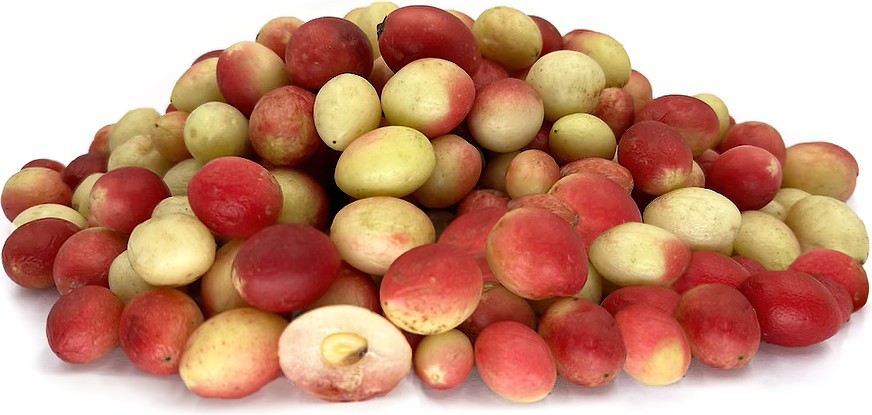


Rukam
Estimated Inventory, lb : 0
This item was last sold on : 06/15/24
Description/Taste
Rukam fruits are small, round to oval berries, averaging 1 to 2 centimeters in diameter, that hang in loose clusters from the branches of the tree. The skin of the fruit is taut, smooth, and firm, ripening from green with a red blush to variegated hues of purple to dark red when ripe. Underneath the surface, the flesh is pale yellow to white with a crisp and aqueous consistency, encasing a long flat seed resembling an olive pit. When immature, the fruits are astringent, hard, and crunchy, with a texture similar to an apple. As Rukam fruits mature, the flesh softens and develops a slightly sweet, acidic, and sour flavor.
Seasons/Availability
Rukam fruits are available in the summer in Asia and Southeast Asia.
Current Facts
Rukam fruits, botanically classified as Flacourtia rukam, are small, tropical berries belonging to the Flacourtiaceae family. Also known as Indian plums, Indian prunes, Coffee plums, and Runeala plums, there are over ninety different varieties of fruits that are generally labeled as Rukam in villages throughout Asia and Southeast Asia. Each variety may exhibit slight differences in color, size, and sweetness, and though the fruits are locally called “plums,” they are not related to and do not resemble fruits of the Prunus genus. Rukam fruits are not commercially cultivated and are most commonly found wild or grown in home gardens, favored for their medicinal nature.
Nutritional Value
Rukam fruits are a good source of fiber, which can help stimulate digestion and aid in the removal of unwanted toxins from the body. The berries also contain vitamin A and some calcium, potassium, iron, and phosphorus.
Applications
Rukam fruits have an acidic, sweet, and sour flavor that can be eaten fresh, out-of-hand, or cooked with added ingredients for a sweeter taste. Immature, firm fruits can be sprinkled with salt, sugar, or chili powder, or sliced into rujak as a crunchy ingredient. It is important to note that the pit is not edible and should be removed before eating. As Rukam fruits ripen, they can be rolled between the palms of the hands to help remove any remaining astringency in the flesh. The soft, ripe flesh can be boiled into a sauce with spices, cooked into jams, compotes, and jellies, or stewed with sugar into a sweet dessert. Rukam fruits can also be dried or pickled for extended use. Rukam fruits pair well with aromatics such as garlic and ginger, spices such as turmeric, cumin, cardamom, cinnamon, and chile powder, and fruits such as citrus, passion fruit, and coconut. The small fruits will keep up to two weeks at room temperature and up to seven weeks when stored in the refrigerator. Rukam fruits can also be frozen whole or mashed into a pulp for extended storage.
Ethnic/Cultural Info
In India, many rural villages use Rukam fruits as natural medicine. In traditional Ayurvedic practices, the fruits are believed to help with eye health, provide a source of energy to the body, and help regulate bowel movements. The seeds are also ground into a powder with other spices and applied topically to reduce pain. Beyond the fruits, the wood of the Rukam tree is used by villages for constructing furniture, tools, and utensils.
Geography/History
Rukam fruits have been growing wild since ancient times and are native to regions across Asia and Southeast Asia. The fruits are commonly associated with India, foraged from tropical forests, and have been used both medicinally and in culinary applications for thousands of years. Today Rukam fruits are still localized to Asia and Southeast Asia, foraged or sold through local markets.
Recipe Ideas
Recipes that include Rukam. One
| Shockingly Delicious |
|
Indian Plum Chutney or Jam |




